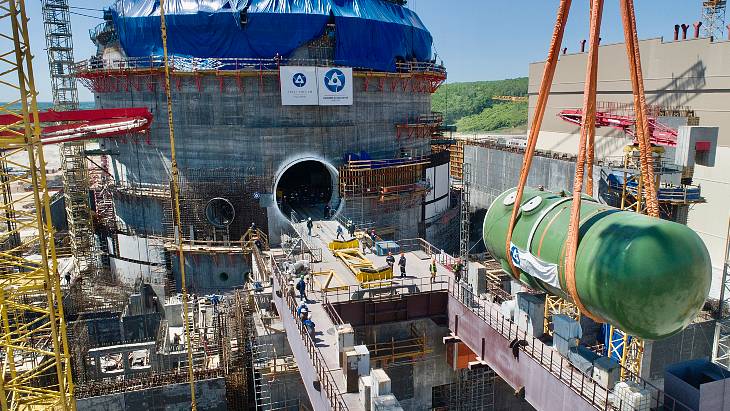The 340-tonne, 12-metre VVER-TOI reactor vessel is made of nickel-free steel and is designed to withstand a pressure of 250 atmospheres, equivalent to the pressure at a depth of 2.5km in the ocean, Rosatom says. It was installed in its final position in the first power unit at Kursk II in western Russia in several stages.

The PWR-TOI reactor vessel at the Kursk II construction site (Image: Rosenergoatom)
The equipment was manufactured at the Atommash plant in Volgodonsk and was delivered to the site in September 2021. Kursk II is the first project to use the VVER-TOI design.
"Since that time, a lot of work has been done to prepare a transport and technological scheme for the installation. The installation of the vessel in its proper location marks the active phase of the installation of the equipment of the reactor plant. This event counts down to the start of commissioning at the nuclear power plant," said Andrey Osharin, first deputy director for the construction of new units of the Kursk nuclear power plant.
To install it, the equipment was moved to the central hall of the reactor compartment and, with the help of a polar crane it was installed on a support ring in the reactor shaft at a mark of 11.3 metres. The maximum allowable deviation during installation was one tenth of a millimeter - this is the thickness of a razor blade, Rosatom said.
"The VVER-TOI reactor vessel has its own characteristics. It differs from the VVER-1200 project not only in a more symmetrical arrangement of nozzles, but also in a smaller number of welds - now there are four of them instead of six, since welded joints in the core area are excluded," said Alexei Volnov, chief engineer of the Kursk plant.
He said this means that it will be possible "after 60 years of operation, to extend the service life of the vessel twice more by 20 years".
The VVER-TOI design was announced in 2010. Kursk II will replace four RBMK units currently operating at the site. The generation III+ power unit has an upgraded pressure vessel, increased power to 3300 MWt and 1255-1300 MWe gross (nominally 1300), improved core design to increase cooling reliability, further development of passive safety with 72-hour grace period requiring no operator intervention after shutdown, lower construction and operating costs, and 40-month construction time. It will use a low-speed turbine-generator.
Oleg Shperle, vice president and director of the Kursk construction project, said that having achieved the "key task of 2022" work would move on to the next phase, of heat installation work and preparing for welding the main circulation pipelines.
Researched and written by World Nuclear News